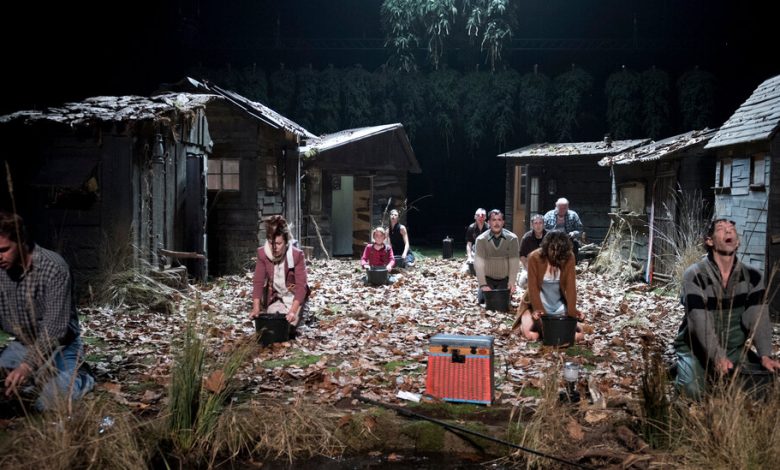A Show With a Cryptic Cryptic Title but No Code to Crack

The Belgian theater collective FC Bergman was still young when it landed an invitation to a prestigious festival in its town, Antwerp, in 2011. “They said, ‘You have one evening — do something,’” Marie Vinck, a company member, recalled in a recent video conversation.
The troupe members, who were finishing drama school, were thrilled — except that they had no money and no time. Still, in just a month, they hatched the sprawling “300 el x 50 el x 30 el,” an ambitious hybrid of theater, installation and live video, with an elaborate set that recreated a rural settlement onstage.
“It was around Christmas time and we thought we could take the Christmas trees out of the streets to create this forest in the back of the theater,” Thomas Verstraeten, another member, said during the same Zoom conversation. “It was a very crazy experience, actually. We invited our friends to be onstage but also our parents, the father of a technician of ours,” he continued. “Marie’s old babysitter was in it. Because it was only once, they said, ‘OK, we’ll do it for free.’”
Despite its abbreviated gestation, the show turned out to have legs: It has toured Europe, and this month will open the Brooklyn Academy of Music’s Next Wave festival on Sept. 28 and run through Oct. 1. It will be FC Bergman’s U.S. debut.
“It’s funny, it’s thought-provoking, it sprang from biblical sources, but it’s 100 percent contemporary,” David Binder, the artistic director of BAM, said of the show in a phone interview. “On one hand it’s pushing boundaries, and on the other hand it has a level of accessibility for everyone.” Well, not quite everyone. Binder quickly added that the evening is unsuitable for children.
The cryptic title refers to the dimensions of Noah’s ark as described in the Bible, and the scale is appropriately awe-inspiring: The village that New York audiences will discover in “300 el x 50 el x 30 el” will accommodate a cast of 15, supplemented by scores of locally hired extras, live pigeons and, of course, that forest. “It’s one of our smaller shows, actually,” Stef Aerts, another company member, said, laughing.
Aerts, 34, Verstraeten, 36, and Vinck, 39, were talking from Stockholm, shortly before a performance of their 2021 production “The Sheep Song,” a poetic fable about a sheep dissatisfied with its fate, at the Royal Dramatic Theater, once the home base of the Belgian troupe’s namesake, Ingmar Bergman. (Missing from the call was Joé Agemans, 40, also part of the collective. The other two founding members left in 2018.) FC Bergman regularly travels to the finest European houses and festivals, and since 2013 it has been a resident company at Antwerp’s municipal theater, Toneelhuis. The group doesn’t need to scavenge discarded goods for its sets anymore, leaving extra time for hatching new concepts.
Indeed, while FC Bergman has tackled existing works, including an adaptation of William Gaddis’s novel “J R” and the Bizet opera “Les Pêcheurs de Perles,” it usually conceives its own, typically wordless, material. For “The Land of Nod” (2015), the collective set a show inspired by Jean-Luc Godard movies and Flemish masters in a custom-built, full-scale replica of the Rubens room at the Royal Museum of Fine Arts in Antwerp, Belgium, garnering comparisons to the physicality and transcendence found in the work of European superstars like Romeo Castellucci and Pina Bausch.
As for “300 el x 50 el x 30 el,” the troupe drew from the aesthetics of the Scandinavian crime series that were becoming popular at the turn of the 2010s. “That was also the period when we discovered the work of the great Swedish filmmaker Roy Andersson, who became a really big influence,” Aerts said, before mentioning “the other Scandinavian guy, Lars von Trier, and also, of course, the Catholic religion and lots of Flemish visual arts.”
Relatively little in this production happens in full view of audience members, who watch the proceedings via a live video feed. “It’s about people who are very much isolated in their mini-community — they live in the village but they don’t interact with each other, only in their little houses and with their little families,” Aerts said. “I think the use of the camera translates this feeling to the audience. You’re just presented the walls of locked houses, but you can peek through the keyhole.”
This leaves viewers a lot of room to superimpose their own narratives and interpretations on the visuals. “We played in Greece in the middle of the Euro crisis and you felt that people saw the show as some kind of a metaphor for their situation,” Verstraeten said. “Now it will become something else. I love the idea that meaning is something that can change all the time.”
The three company members also emphasized that there is no right or wrong way to read the show.
“I hope that the audience permits itself to be very open and to not have the urge to analyze it or to find a key, to crack the code,” Aerts said. “You have to get underwater and let the performance flow over you.”
